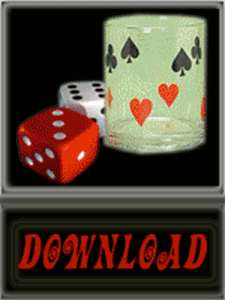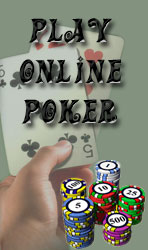Pokerwiner.com → Lessons of poker
DECEPTION AND THE ABILITY OF YOUR OPPONENTS
A question you must always address, then, is when to play a hand straightforwardly and when to use deception. The most important criterion for making this decision is the ability of your opponents.
The tougher they are, the more you must consider playing a hand other than optimally to throw them off. The weaker they are, the more you can get away with optimum play.
Thus, if you have a good hand on an early round, you would not put in that last raise against tough players, but with a weaker hand you might consider putting in an extra bet to make your opponents think your hand is stronger than it is.
For example, with a three-flush on third street in seven card stud you might throw in a reraise to create the wrong impression.
Now if you happen to pair on board, you have the extra equity that your opponent may fold incorrectly, afraid you have three-of-a-kind or two pair.
On the other hand, if you are playing against dunces or just mediocre players, you don’t gain enough in deception to justify the cost.
Against such players you should put in an extra raise when you think you have the best hand, but throwing in an extra bet with a weaker poker hand, against someone who won’t fold anyway, simply costs you extra money.
In using deception, them, you must weigh the ability of your opponents against the extra cost.
DECEPTION AND THE SIZE OF THE POT
Another criterion for deciding how to play a hand is the size of the pot. As the pot grows larger and larger, it becomes less and less important to disguise your hand because good players are not likely to fold any more than bad players are.
Nor will good players try to bluff as much when you show weakness, because they too recognize that the pot is so big there is almost no chance you will fold. So when pot has become large, you usually no longer have to think about using deception.
DECEPTION AND BET SIZE
There is a related concept. If early bets are much smaller than later bets, you usually shouldn’t throw in a small raise with a big hand.
You may put people on guard so that even if they don’t fold immediately, they will when the best increase in later rounds.
You’re likely to get more action on your big hands by slow poker playing them.
Conversely, with a large increase in bets from one round to another, you may decide to put in extra action with a weaker hand on a early, cheap betting round to create the wrong impression later when the best are expensive.
Thus, you should consider not only the amount in the pot odds now but also how much the bets are now compared to what may be later.
You might check a big hand early to win big bets later, and on the other hand, you might bet with a weaker hand early in hopes that your opponents will check later to give you a free card.
Obviously, you can better afford to disguise your hand in early rounds in pot-limit and no-limit poker games than in limit games, since both the size of the pot and the size of the bets may increase enormously from one round of betting to the next.
With a big hand and a lot of money in front of you, you can check and give your opponents many more free cards.
You are not so concerned about protecting the money in the pot as you are about getting paid off when you bet a much larger amount later.
Furthermore, it costs too much to protect small pots, especially when you have only a fair hand.
To win them, you need to make a considerably bigger bet than you would in limit games, and so in no-limit you would tend to give more free cards even when you are not altogether happy about it. (See Chapter Ten, “The Free Card,”)



